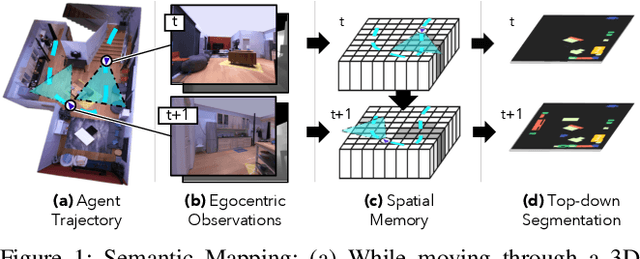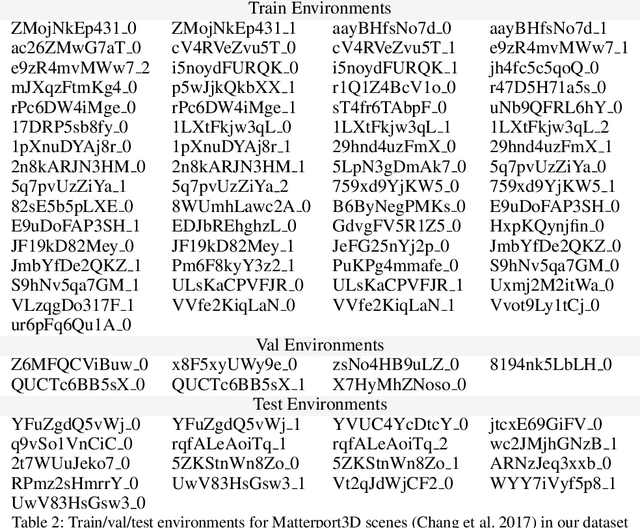Neha Jain
3D Semantic MapNet: Building Maps for Multi-Object Re-Identification in 3D
Mar 19, 2024



Abstract:We study the task of 3D multi-object re-identification from embodied tours. Specifically, an agent is given two tours of an environment (e.g. an apartment) under two different layouts (e.g. arrangements of furniture). Its task is to detect and re-identify objects in 3D - e.g. a "sofa" moved from location A to B, a new "chair" in the second layout at location C, or a "lamp" from location D in the first layout missing in the second. To support this task, we create an automated infrastructure to generate paired egocentric tours of initial/modified layouts in the Habitat simulator using Matterport3D scenes, YCB and Google-scanned objects. We present 3D Semantic MapNet (3D-SMNet) - a two-stage re-identification model consisting of (1) a 3D object detector that operates on RGB-D videos with known pose, and (2) a differentiable object matching module that solves correspondence estimation between two sets of 3D bounding boxes. Overall, 3D-SMNet builds object-based maps of each layout and then uses a differentiable matcher to re-identify objects across the tours. After training 3D-SMNet on our generated episodes, we demonstrate zero-shot transfer to real-world rearrangement scenarios by instantiating our task in Replica, Active Vision, and RIO environments depicting rearrangements. On all datasets, we find 3D-SMNet outperforms competitive baselines. Further, we show jointly training on real and generated episodes can lead to significant improvements over training on real data alone.
Semantic MapNet: Building Allocentric SemanticMaps and Representations from Egocentric Views
Oct 02, 2020



Abstract:We study the task of semantic mapping - specifically, an embodied agent (a robot or an egocentric AI assistant) is given a tour of a new environment and asked to build an allocentric top-down semantic map ("what is where?") from egocentric observations of an RGB-D camera with known pose (via localization sensors). Towards this goal, we present SemanticMapNet (SMNet), which consists of: (1) an Egocentric Visual Encoder that encodes each egocentric RGB-D frame, (2) a Feature Projector that projects egocentric features to appropriate locations on a floor-plan, (3) a Spatial Memory Tensor of size floor-plan length x width x feature-dims that learns to accumulate projected egocentric features, and (4) a Map Decoder that uses the memory tensor to produce semantic top-down maps. SMNet combines the strengths of (known) projective camera geometry and neural representation learning. On the task of semantic mapping in the Matterport3D dataset, SMNet significantly outperforms competitive baselines by 4.01-16.81% (absolute) on mean-IoU and 3.81-19.69% (absolute) on Boundary-F1 metrics. Moreover, we show how to use the neural episodic memories and spatio-semantic allocentric representations build by SMNet for subsequent tasks in the same space - navigating to objects seen during the tour("Find chair") or answering questions about the space ("How many chairs did you see in the house?").
 Add to Chrome
Add to Chrome Add to Firefox
Add to Firefox Add to Edge
Add to Edge